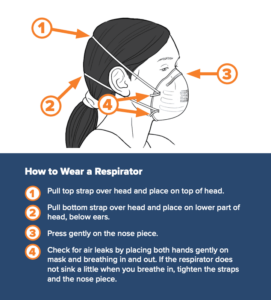
The 2024 wildfire season began earlier than expected, with multiple fires igniting across California. Over 1 million acres have already burned, marking a 70% increase compared to last year. Recent wet winters encouraged significant vegetation growth, creating ample fuel for these fires. With more than 6,500 wildfires reported so far and the season still ongoing, the risk of further destruction remains high.
As agricultural harvest overlaps with peak wildfire season, it’s crucial for the industry to be well-prepared. The convergence of harvest and wildfire seasons heightens the need for effective disaster preparedness and response strategies.
In 2021, the California Department of Industrial Relations’ Occupational Safety and Standards Board implemented a safety standard designed to protect outdoor workers from the harmful effects of wildfire smoke. This regulation applies to outdoor worksites where the current Air Quality Index (AQI) for airborne particulate matter (PM) reaches 151 or higher and where employers can reasonably anticipate that employees could be exposed to wildfire smoke. This article provides an overview of wildfire safety regulations and employee protection measures. It also highlights best practices for safeguarding your workforce during wildfire or smoke exposure, ensuring their health and safety in these challenging conditions.
Have A Plan and Reduce Exposure
As with many of the other Cal/OSHA regulations, the Wildfire Smoke Prevention Standard requires employers to develop an emergency action plan. This plan must include clearly defined evacuation routes for all work locations and be communicated effectively to employees. It’s also important to have backup plans in place. If poor air quality is anticipated, consider adjusting work schedules, relocating to a site with better air quality or moving indoors.
A best practice is to coordinate with local emergency services. Share your plan details, including worksite locations, communication strategies and proposed evacuation routes, and seek their input before an incident occurs.
Monitor Air Quality
The person overseeing outdoor crews must regularly monitor the AQI for PM 2.5 before and during shifts. The AQI measures air pollution on a scale of 0 to 500, with values from 0 to 50 indicating good air quality, 51 to 100 considered moderate, 101 to 150 unhealthy for sensitive groups, and 151 to 200 unhealthy for all. PM 2.5 refers to fine particles, 2.5 micrometers or smaller—about 30 times smaller than the width of a human hair—that can harm the lungs and heart when inhaled.
If the AQI is below 50, PM 2.5 levels are within the healthy range. However, when the AQI exceeds 201, outdoor work becomes hazardous due to dangerous PM 2.5 concentrations. To ensure safety, monitor AQI levels throughout the day, as they tend to worsen in the afternoon. Local AQI and PM 2.5 data can be accessed via resources like U.S. EPA AirNow, the U.S. Forest Service, the California Air Resources Board and local air pollution districts. Regular checks are necessary to adjust work plans based on current air quality.
Have Respirators Ready
The Wildfire Smoke Prevention Regulation requires employers to provide respiratory protection equipment that filters out fine particles. Respirators must be labeled N-95, N-99, N-100, R-95, P-95, P-99 or P-100, and be approved by the U.S. National Institute for Occupational Safety and Health. If the AQI is 151 or higher but does not exceed 500, respirators must be made available to employees for voluntary use. If the AQI is 500 or greater, then respirators are required to be worn. As a best practice, ensure you have an ample supply of respirators in your inventory for your employees throughout the season.

Train Employees
A key component of your Wildfire Smoke Protection Plan is ensuring your employees receive proper training. The regulation mandates that your training program covers the following topics:
• The health effects of wildfire smoke.
• The right to obtain medical treatment without fear of reprisal.
• How employees can obtain the current AQI (provide them with the website.)
• Share your two-way communication system with workers on how you will keep them updated on changing conditions.
• Provide complaint respirators, show them how to use and maintain them, and encourage them to use them (they can refuse to wear one and if someone does, there needs to be a waiver where they sign off that they were offered a respirator and declined to use it.) The employer must require employees to use respirators when the AQI for PM2.5 is greater than 500.
• The importance, limitations and benefits of using a respirator when exposed to wildfire smoke.
• What you will do to protect them from smoke (i.e., when you will stop work, when you will move them to another location, etc.).
It is highly recommended that all businesses with an outdoor workforce review the Cal/OSHA regulation, which can be found at dir.ca.gov/title8/5141_1.html. For additional assistance on developing your Wildfire Smoke Protection Plan or worker training, please contact AgSafe at safeinfo@agsafe.org.
AgSafe is a 501c3 nonprofit providing training, education, outreach and tools in the areas of safety, labor relations, pesticide compliance and human resources for the agricultural community. Since 1991, AgSafe has educated over 150,000 employers, supervisors and workers about these critical issues.















